|
|
JAMES BOND FACT FILES |
|
|
JAMES BOND FACT FILES |
|
||||
 |
||||
|
When Ian Fleming's sixth James Bond novel was published in London by Jonathan Cape, journalist and critic Paul Johnson (1928-2023) famously decried DR. NO's ‘sex, snobbery and sadism’ in his review in The New Statesman on April 5, 1958. DR. NO was the first of Fleming's Bond novels to face widespread negative criticism in the UK. When the American edition was published in June of 1958, The New York Times ran a large advertisement to promote the Macmillan hardback and introduce the author to US readers. The advertisement highlighted the controversy in the British press and printed some of the more positive comments from American reviewers of Fleming's earlier James Bond novels. The advertisement also alerted readers that Ian Fleming's non-fiction book The Diamond Smugglers would be published in hardback on May 13, 1958. |
||||
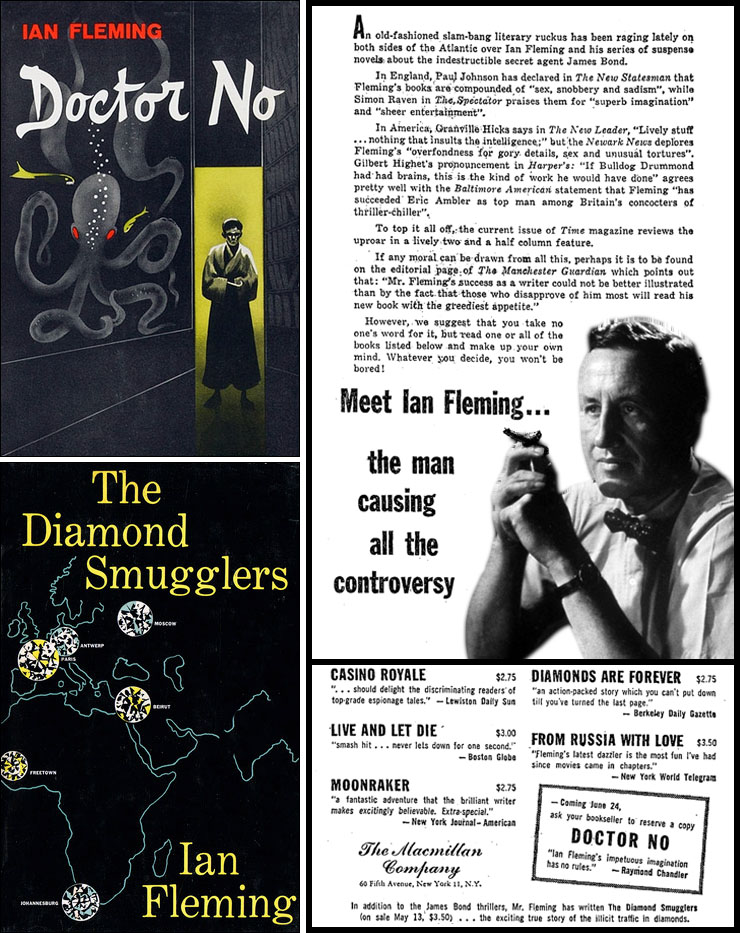 |
||||
|
The dust jacket for DOCTOR NO was again designed by H. Lawrence Hoffmann and featured an illustration of the pincer-handed eponymous villain framed in a doorway, next to an aquarium window with a giant octopus and exotic fish. The novel itself had American spellings of several English words, but in all other respects was identical to its Jonathan Cape counterpart. It is interesting to note however that the title of the novel was spelled in full rather than the abbreviated UK version. The dust jacket for The Diamond Smugglers was also designed by H. Lawrence Hoffmann, and featured a simple but effective map of Europe, Asia and Africa, with diamonds indicating strategic trading and smuggling cities mentioned in the book. |
||||
|
|
||||
|
A series of smaller advertisements appeared in the US press in the weeks after the publication of DOCTOR NO, all inviting the public to ‘decide for themselves’, picking out some of the more lurid reviews from both sides of the Atlantic. Anthony Boucher was less than enthusiastic in his New York Times review of July 6, 1958:
The review was almost a rehash of his 1957 assault on FROM RUSSIA, WITH LOVE. Many other US reviewers were more positive, with James Sandoe in the rival New York Herald Tribune writing that DOCTOR NO was "... the most artfully bold, dizzying poised thriller of the decade. You'd much better read it than read about it". |
||||
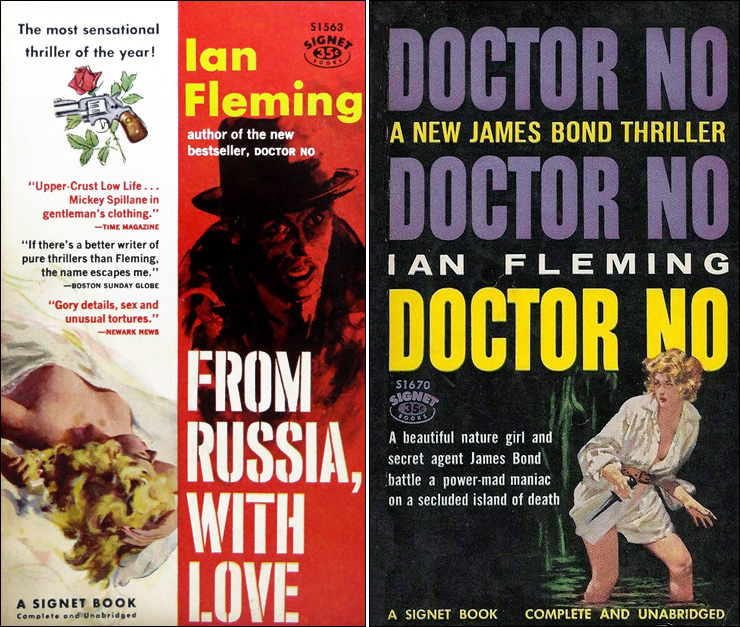 |
||||
|
The paperback rights to publish the James Bond novels in the US were now acquired by The New American Library, and published under their Signet Books imprint. Their first release was FROM RUSSIA, WITH LOVE in September 1958, followed by DOCTOR NO in July 1959. Both paperbacks had cover artwork painted by Barye Phillips (1924–1969) who had started his career in the Columbia Studios art department during the early 1940s. Later known as ‘King of the Paperbacks’ and able to work in a variety of styles, Phillips could turn out four illustrations a week, and would later paint the vignettes that appeared on Signet's range of James Bond paperbacks throughout the 1960s. The FROM RUSSIA, WITH LOVE paperback featured a small painted version of the Richard Chopping gun-and-rose motif that appeared on the UK and US hardback editions of the novel. The DOCTOR NO paperback features a painting of Honey Rider, wearing slightly more clothes than in her introductory scene in the novel. |
||||
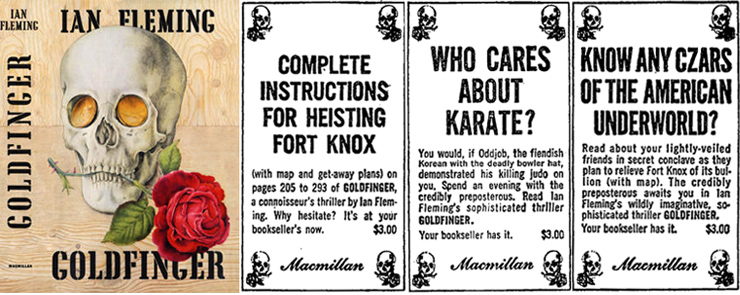 |
||||
|
Richard Chopping's trompe l'oeil artwork which appeared on the Jonathan Cape UK hardback of GOLDFINGER was also used on the US Macmillan hardback edition published in New York on August 18, 1959. The book itself was printed in England and does not include any American spellings of English words. In the days following its publication the New York Times once again ran a series of clever advertisements promoting its release. With a larger print run of 7,500 copies, the US reviews were the best yet which pleased the author, and even Anthony Boucher of the New York Times was more positive than usual:
GOLDFINGER was also favourably reviewed in the October 1959 issue of PLAYBOY Magazine. This marked the first mention of Ian Fleming in Hugh Hefner's periodical, and began a long association with the James Bond character which continues to this day. |
||||
 |
||||
|
October 1959 saw the publication of LIVE AND LET DIE in paperback by Signet Books, followed in February 1960 by CASINO ROYALE. This marked the first time that Ian Fleming's first James Bond novel had been published in the USA in paperback with its original title. Both paperbacks had cover artwork by Barye Phillips and reminded the reader that this book was a James Bond thriller by the author of DOCTOR NO. |
||||
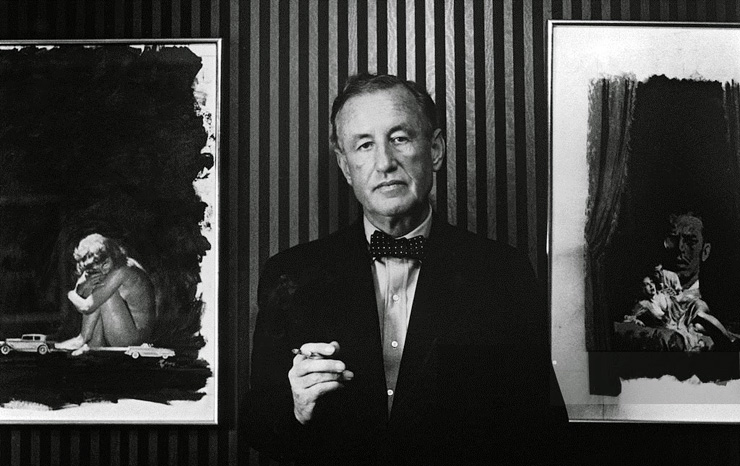 |
||||
|
First published in the UK on April 11, 1960, FOR YOUR EYES ONLY was an anthology of five Ian Fleming short stories originally written for an aborted US CBS television series. Prior to being collected together in one volume, three of the stories had appeared in UK and US magazines. FROM A VIEW TO A KILL was serialized in five instalments in the Daily Express in September 1959 under the title Murder Before Breakfast, with drawings by Andrew Robb. THE HILDEBRAND RARITY made its debut in the March 1960 issue of PLAYBOY magazine, with a superb full-page illustration by Alan Phillips; and QUANTUM OF SOLACE first appeared in the US magazine Cosmopolitan in May 1959; and again in the UK as ‘Short novel of the month’ in the November 1959 issue of Modern Woman, under the title A Pattern of Love and Hate. |
||||
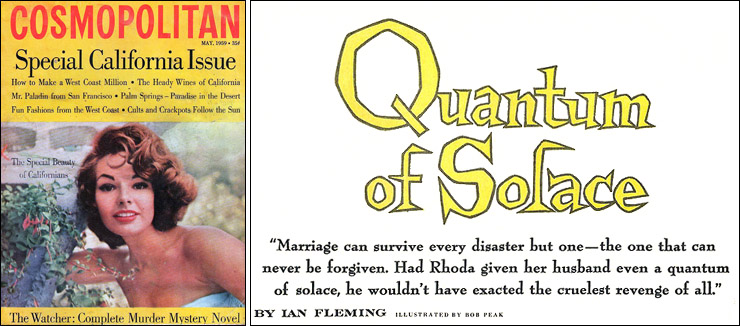 |
||||
|
The Cosmopolitan publication was accompanied by three colour illustrations and a decorative title by Bob Peak (1927-1992), who would later produce the striking poster artwork for The Spy Who Loved Me in 1977, and unused early concept artwork for Licence To Kill in 1989. RISICO, FROM A VIEW TO A KILL and FOR YOUR EYES ONLY would later be adapted for the Daily Express comic strip drawn by John McLusky (1923-2006) from April - December 1961, with THE HILDEBRAND RARITY eventually appearing in May - December 1967, this time illustrated by Yaroslav Horak (1927-2020). |
||||
|
||||
|
The US edition of FOR YOUR EYES ONLY was published in New York in May 1960 by the Viking Press. Ian Fleming had decided to change his US publisher on the recommendation of his close friends Graham Greene (1904-1991) and Peter Quennell (1905-1993) who were both published by Viking. Fleming had felt lost in the huge firm of Macmillan, and wanted a smaller company to handle his novels in America. The Viking Press hardback of FOR YOUR EYES ONLY featured some American spelling of English words, and also amended the original subtitle to read Five secret exploits of James Bond. The Jonathan Cape edition had the subtitle Five secret occasions in the life of James Bond. Although the US Viking Press edition used the same Richard Chopping dust jacket artwork as its Jonathan Cape counterpart, the title lettering had to be adapted to fit the slightly larger format of the US hardback. The spine lettering also read top to bottom (as was traditional on most US books) making the title easier to read when the book was placed on its side, whereas European publications usually have the text reversed making them easier to identify on a bookshelf. |
||||
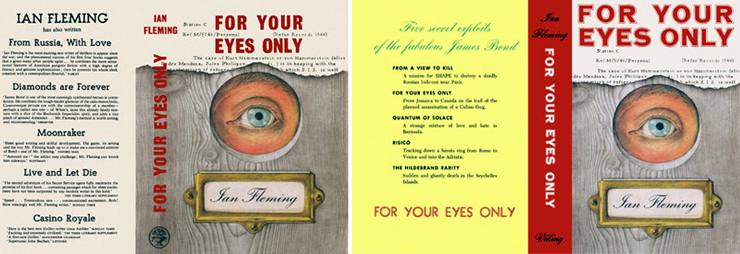 |
||||
|
Signet then released paperback editions of GOLDFINGER in June of 1960, followed in October by the first US edition of MOONRAKER with its original title. Both featured eye-catching illustrations by Barye Phillips. The covers of both paperbacks again highlighted that the title was by the author of DOCTOR NO, which was still the most widely-known of Fleming's novels in the USA. FOR YOUR EYES ONLY became the next Signet paperback in June 1961, again with an illustration by Barye Phillips and marked the last title issued before the series was republished with uniform covers. |
||||
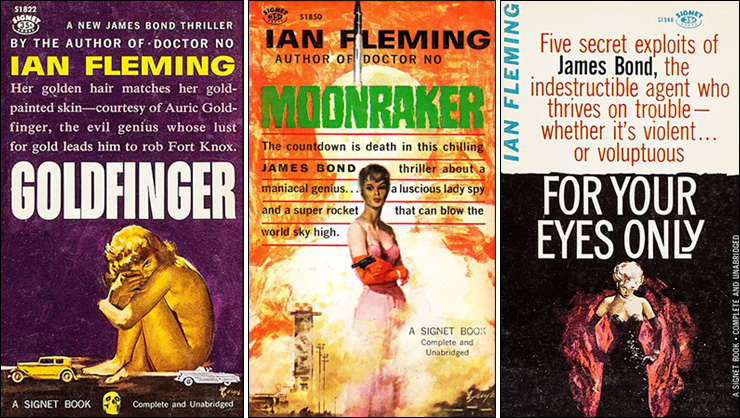 |
||||
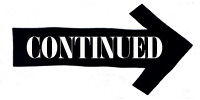 |
||||